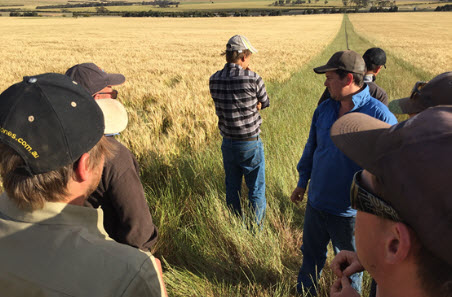Gaining grazing crop confidence

A new MLA-funded paddock demonstration will improve producer knowledge of maximising both livestock and grain production from dual-purpose crops.
To boost local producer confidence in using grazing crops to fill the winter feed gap, south-western farming systems groups Southern Dirt and the Facey Group have joined forces to run an MLA Producer Demonstration Sites (PDS) project.
Due for completion in 2020, the PDS will analyse sheep and crop enterprise production and economics when grazing crops in a range of seasons, soil types and market conditions.
The project will test:
- the potential for a 10% minimum improvement in condition score of twin bearing ewes that graze crops, compared to those run on pastures at traditional stocking rates.
- if feed on offer levels can be doubled in deferred or rested pastures.
Having already used strategic crop grazing in his enterprise, Wagin sheep producer Clayton South is hosting one of the four PDS sites.
Clayton said grazing of early-sown winter cereal crops in autumn/early winter can defer pasture paddocks, allowing plant growth to get away. This helps boost the pasture feedbase for spring lambing requirements, with little or no penalties to crop grain yields.
On a whole-farm basis, this enables more livestock to be run, higher stocking rates to be used and/or cropping areas to be expanded. There may also be positive spin-offs in helping to mitigate the effects of frost and disease in-crop in some situations and seasons.
But crop grazing, according to Clayton, comes with the risk of lower grain yields if not managed well, or if there is a hot or dry season finish.
Exploring options
Clayton said barley crop grazing had led to improved whole-farm returns, when coinciding with late winter-spring rain and mild temperatures.
“Each year our mindset is to go into the cropping season planning not to graze crops, because we don’t want grain yields penalised,” he said.
“But in seasons like 2017, when crops get away really well, we will graze them.
“We play the season and sometimes we plant a sacrificial crop, such as oats or barley, to lock-up to wean ewe lambs on to at the end of the season.
“Barley crops are by far the best fit for grazing for us because they are more vigorous than wheat and can be sown early enough to be established for grazing when there is a sheep feed gap in late autumn and early winter.”
Trial improves sheep condition score
The PDS trial at Clayton’s property was established on 110ha sown to Scope CL barley on 17 May 2017.
A mob of 60 twin bearing ewes were introduced on 21 June, when plants were at early tillering stage, and removed on 27 July.
Ewe condition score was recorded on entry and exit for comparison to a similar mob of 60 ewes on traditional pastures at common regional stocking rates of nine dry sheep equivalent (DSE)/ha.
At the end of the grazing period, the condition score of the ewes run on the barley crop was 0.5 higher than the pasture grazing mob average. There was no significant difference in the number of lambs born or surviving.
Clayton said only 5–10ha of the cropped area showed visual signs of grazing damage, but this soon recovered to the condition of the remainder of the paddock. Grain yield will be assessed following harvest, due to get underway shortly. The ewes will also be monitored into 2018 for conception and weaning results.
The trials will be carried out on different soil types in each of the three years of the project.
Clayton said the successes noted in the first year had lifted his confidence in potentially using crop grazing more regularly, but possibly with a lower stocking rate on bigger cropped areas.
“We know we can boost the condition scores of the ewes and if the yield penalty is only small, we can wear that," he said.
A collaborative approach to learning
WA farm consultant, Ed Riggall of AgPro Management, is helping to coordinate the Southern Dirt and Facey Group PDS project and said the four local trial sites will expose about 2,600 farming businesses to the benefits and potential pit falls of crop grazing.
“Productivity-driven sheep enterprise profits are hitting a ceiling in this region and we want to focus on the autumn-winter period that limits stocking rates and animal growth rates due to lack of available feed, or to see if we can reduce the costs of supplementary feeding at this time,” he said.
Ed said most of the downside of grazing crops is associated with grazing too hard too late in the season, or grazing weedy crops.
“This, combined with a poor finish, can lead to big grain yield penalties,” he said.
According to Ed, the upsides from a well-managed crop are:
- less costs of supplementary feeding
- having sheep in better condition
- being able to rest pastures.
Research and modelling for other regions of WA have indicated crop grazing can deliver losses of up to $97/ha (in reduced yields) in some years and gains of up to $322/ha in others.
More information
Ed Riggall
Farm Consultant, AgPro Management
T: 0428 299 007
E: ed@agpromanagement.com
Michael Crowley
General Manager – Producer Consultation and Adoption, MLA
E: mcrowley@mla.com.au
Want to get involved?
MLA Producer Demonstration Sites: mla.com.au/pds.



